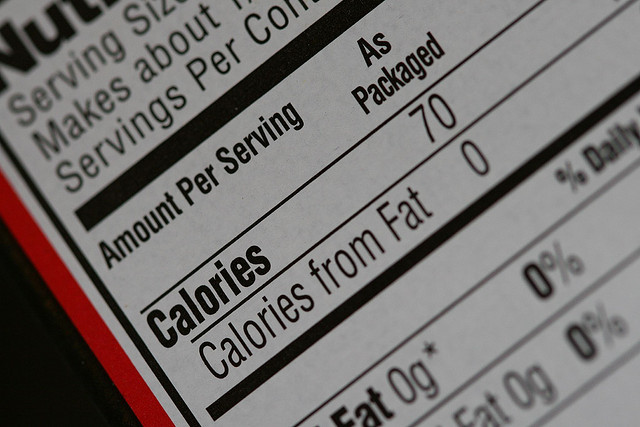
Reading nutritional labels in the right order will give you a better insight into what foods to eat.
Photo courtesy of Andy Perkins (Flickr)
We know we should be watching what we eat and what our food is made of, but actually doing so is easier said than done. A food label with all of the nutrition information of an item usually has everything you need to know to make an educated decision about what to eat, but only if you know what you are looking at. Although a lot of nutrients are listed, if you break down a food label and look at it piece by piece, it can be a lot less overwhelming and more helpful. Knowing a few key pieces to look for can make analyzing a food more effective and faster.
Starting at the top of the food label, be sure to take note of “Servings Per Container.” This can reveal a lot about an item and can make big differences in nutrition. For example, one candy bar generally has more than one serving per container. If you eat the entire bar, you are getting at least twice of everything listed. If an item has two servings and you want to determine the nutrition of the entire item, you would simply multiply everything by two. This is important to look for in any food item.
Calories, while not the only important thing listed, can tell you a lot about a food. Be sure to take into considering the servings per container to determine how many calories you are actually going to get. Calories may become important to watch in something that you are perfectly aware is unhealthy, so you only want to indulge in a small amount of it.
Before looking at overall fat, take a closer look at the breakdown of kinds of fat first. If something is really high in saturated or trans fat, that is something that also may be an indulgent food that you only want to have a small amount of. If a food is high in mono- or poly-unsaturated fats, such as nuts or nut butter, the overall amount of fat becomes less important. Although the overall amount will still be high, that is okay in something that provides healthy fats.
Moving down the label, sodium might be your next nutrient to watch, especially in processed foods. This includes any kind of pre-made snack such as crackers or chips and frozen foods such as pre-made meals. A general rule of thumb is the less sodium, the better. This is one nutrient where looking at the “% Daily Value” may be helpful. Although these daily value percentages do not apply to everyone’s dietary needs, they can give you a good estimate of how much of your daily amount of sodium is in any given product. If you are having something as part of your meal, such as soup, then a sodium level around 30 percent of your daily value would make sense. If it is just a snack and it has over 10 percent of your daily value, eating that food may be something to reconsider.
Total carbohydrates may be important in some cases, but often looking at the items below it — dietary fiber and sugar—for relevant information can tell you more essential information about a food. Carbohydrates are the macronutrient most of our calories should come from.
Protein is another nutrient that will keep you full and you should try to incorporate some protein in every meal or snack. If you are following a normal food plan and are not trying to change amounts of macronutrients, try to have meals with at least fifteen grams of protein each and include around five grams in any snacks.
Vitamins and minerals listed below the big nutrients are always a good thing. The only time you need to really pay attention to high numbers in this area is when it comes to supplements, which tend to have way more than you need. Use the percentage listed by each nutrient to get about 100 percent of each vitamin and mineral per day. There is no need to have much more than this, as it will either not be digested or could be potentially harmful in really high amounts.
Different foods require attention to different parts of the food label and knowing how to break food labels down can make decisions at the grocery store a lot easier. If you are sick of reading food labels, go for fruits and vegetables. They don’t tend to have food labels because they don’t need to, as you can be sure that a fruit or vegetable will have lots of good things for you.


